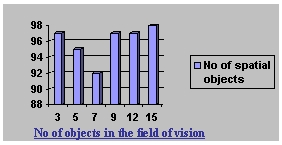ASA/CAA '05 Meeting, Vancouver, BC



Sharpening Ultrasonic Vision for the Blind
Iftekhar Alam- iftekharalamk@yahoo.com
Ashok Ghatol
Pune Institute of Engg and Technology
Shivajinagar, Pune; INDIA - 411 005
Popular version of paper 3aPP1
Presented Wednesday morning, May 18, 2005
Joint ASA/CAA Meeting, Vancouver, BC
Blindness is a sensory disability which is difficult to treat but can to some
extent be helped by artificial aids. This paper describes a method for enabling
blind persons to pinpoint objects in their environment to high accuracy by bouncing
ultrasound from them. Such "ultrasound eyeglasses" are called "sonoculars"
(sonic binoculars) and several systems have already been developed. However,
there is a way to improve their accuracy. In our work, we have developed a technique
in which sonoculars would be able to receive highly precise "direction
of arrival" (DoA) information of incoming echoes. In turn, such a capability
would allow visually impaired persons to localize (determine the location) of
nearby objects with higher precision than possible before.
Throughout history, the staff, or long cane, has provided visually impaired
persons with information about their immediate surroundings. By using the sense
of touch, such persons protect themselves against collisions with objects. But
what has been most significantly missing in this form of travel is reliable
information about objects farther away than 6 meters or so. In addition, it
is also difficult for a blind person to judge the distance between nearby objects.
Thus, it has been suggested that an ability to use ultrasound echoes leads to
superior mobility in the blind. Some species--most notably bats--use this "echolocation"
to decrease dependence on their poor vision when hunting and navigating at night.
INTRODUCTION
The proposed visual aid acts as a "sonocular perception system," which
is a vision substitution aid for enabling blind persons. The blind person wears
"ultrasonic eyeglasses" which has an array of ultrasonic sensors embedded in
it. The ultrasonic signal, covering a narrow frequency band, is reflected back
by the objects, falling in the ultrasound beam and is received. The received
signal is "massaged" and processed before being converted to audible
sound signals sent to both ears at once.
To allow a blind person to have a near-visual experience, making it easier to
avoid obstacles, the system must have the ability to detect weak echoes in the
presence of strong echoes. This paper presents a technique for performing this
necessary calculation. We have developed a robust algorithm for estimating the
Direction of Arrival (DoA) of the ultrasound. Our algorithm separates the spatial
ultrasound data into signal and noise components. In this paper, we propose
and investigate this "subspace" DoA algorithm.. This technique/algorithm
has been found to give good results in localizing objects and distinguishing
between objects which are close together horizontally (i.e., they have a small
azimuthal angle).
SIMULATION RESULTS
Using a computer simulation, we compared the performance of our DoA algorithm
to another algorithm called MUSIC. The simulation results in figure 1 provide
the following comparison-
- Our algorithm had two degrees better resolution. Using our simulated ultrasound
signals, MUSIC could resolve objects with an azimuthal separation of 9°
(9 degrees) whereas the resolution of our proposed algorithm is 7°.

Figure 1: Comparison of function F(θ) v/s bearing angle (resolution) with MUSIC algorithm
Other Advantages over MUSIC Algorithm
The following are the other advantages of the proposed algorithm over the MUSIC
algorithm:
(a) The bearing resolution (the resolution with which one can determine the
angle between the wearer and the source) improves with increase in number of
ultrasound input samples. For any given number of samples (N), the resolution
achieved by the proposed algorithm is better as compared with MUSIC. Thus, for
MUSIC algorithm the number of input samples required to achieve the required
resolution is more.
(b) Our algorithm distinguishes very weak sound sources in the vicinity of strong
ones and its resolution is not sensitively dependent upon the difference in
echo level between two adjacent sources. It is also inferred from the simulations
that MUSIC can distinguish between two targets with strong echo levels and a
small amplitude difference between them.
CONCLUSION
Our DoA algorithm has achieved resolution better than that from the MUSIC algorithm.
Several experiments have been carried out on actual subjects, by simulating
'auditory events' derived and mapped from this algorithm. The experiments carried
out have provided very encouraging results. The results are indicated in figure
2.

Figure 2: Results of perception experiments carried out on ten subjects